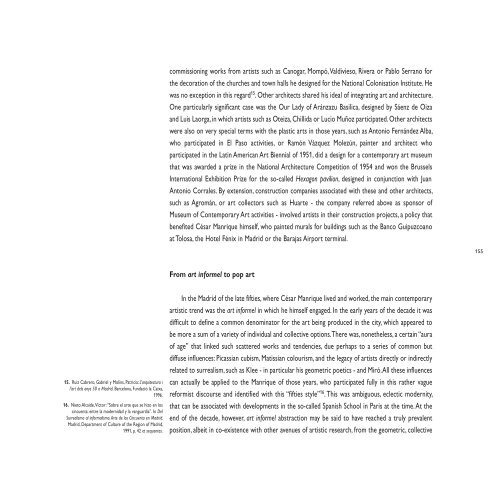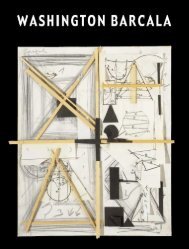VERSIÓN INGLESA ENGLISH VERSION - Fundación César Manrique
VERSIÓN INGLESA ENGLISH VERSION - Fundación César Manrique
VERSIÓN INGLESA ENGLISH VERSION - Fundación César Manrique
You also want an ePaper? Increase the reach of your titles
YUMPU automatically turns print PDFs into web optimized ePapers that Google loves.
15. Ruiz Cabrero, Gabriel y Molins, Patricia: L’arquitectura i<br />
l’art dels anys 50 a Madrid. Barcelona, Fundació la Caixa,<br />
1996.<br />
16. Nieto Alcaide, Víctor: “Sobre el arte que se hizo en los<br />
cincuenta: entre la modernidad y la vanguardia”. In Del<br />
Surrealismo al informalismo. Arte de los Cincuenta en Madrid.<br />
Madrid, Department of Culture of the Region of Madrid,<br />
1991, p. 42 et sequentes.<br />
commissioning works from artists such as Canogar, Mompó, Valdivieso, Rivera or Pablo Serrano for<br />
the decoration of the churches and town halls he designed for the National Colonisation Institute. He<br />
was no exception in this regard 15 . Other architects shared his ideal of integrating art and architecture.<br />
One particularly significant case was the Our Lady of Aránzazu Basilica, designed by Sáenz de Oiza<br />
and Luis Laorga, in which artists such as Oteiza, Chillida or Lucio Muñoz participated. Other architects<br />
were also on very special terms with the plastic arts in those years, such as Antonio Fernández Alba,<br />
who participated in El Paso activities, or Ramón Vázquez Molezún, painter and architect who<br />
participated in the Latin American Art Biennial of 1951, did a design for a contemporary art museum<br />
that was awarded a prize in the National Architecture Competition of 1954 and won the Brussels<br />
International Exhibition Prize for the so-called Hexagon pavilion, designed in conjunction with Juan<br />
Antonio Corrales. By extension, construction companies associated with these and other architects,<br />
such as Agromán, or art collectors such as Huarte - the company referred above as sponsor of<br />
Museum of Contemporary Art activities - involved artists in their construction projects, a policy that<br />
benefited <strong>César</strong> <strong>Manrique</strong> himself, who painted murals for buildings such as the Banco Guipuzcoano<br />
at Tolosa, the Hotel Fénix in Madrid or the Barajas Airport terminal.<br />
From art informel to pop art<br />
In the Madrid of the late fifties, where <strong>César</strong> <strong>Manrique</strong> lived and worked, the main contemporary<br />
artistic trend was the art informel in which he himself engaged. In the early years of the decade it was<br />
difficult to define a common denominator for the art being produced in the city, which appeared to<br />
be more a sum of a variety of individual and collective options. There was, nonetheless, a certain “aura<br />
of age” that linked such scattered works and tendencies, due perhaps to a series of common but<br />
diffuse influences: Picassian cubism, Matissian colourism, and the legacy of artists directly or indirectly<br />
related to surrealism, such as Klee - in particular his geometric poetics - and Miró. All these influences<br />
can actually be applied to the <strong>Manrique</strong> of those years, who participated fully in this rather vague<br />
reformist discourse and identified with this “fifties style” 16 . This was ambiguous, eclectic modernity,<br />
that can be associated with developments in the so-called Spanish School in Paris at the time. At the<br />
end of the decade, however, art informel abstraction may be said to have reached a truly prevalent<br />
position, albeit in co-existence with other avenues of artistic research, from the geometric, collective<br />
155
















![Becas y premios de la Fundación César Manrique [1997-2006]](https://img.yumpu.com/20766851/1/184x260/becas-y-premios-de-la-fundacion-cesar-manrique-1997-2006.jpg?quality=85)
